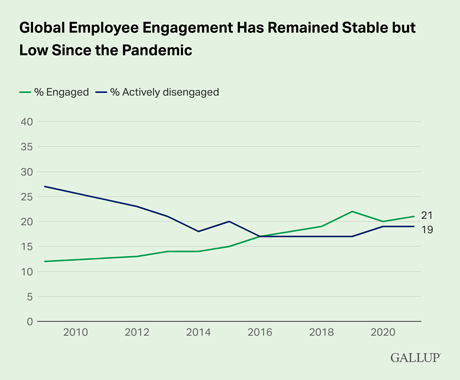Story Highlights
- Young workers, women and remote-ready on-site workers dropped in engagement
- Fully remote employees increased in “quiet quitting”
- Clarity of expectations fell across demographic categories and job types
After trending up in recent years, employee engagement in the U.S. saw its first annual decline in a decade -- dropping from 36% engaged employees in 2020 to 34% in 2021.
This pattern continued into 2022, as 32% of full- and part-time employees working for organizations are now engaged, while 18% are actively disengaged. Active disengagement increased by two percentage points from 2021 and four points from 2020.
The ratio of engaged to actively disengaged workers in the U.S. is 1.8-to-1, down from 2.1-to-1 in 2021 and 2.6-to-1 in 2020. This is the lowest ratio of engaged to actively disengaged employees in the U.S. since 2013, almost a decade earlier. The record high is a ratio of 2.7-to-1 recorded in 2019.
Gallup measures employee engagement by asking random samples of the working population about specific workplace elements that link to many organizational outcomes, including profitability, productivity, customer service, retention, safety and overall wellbeing. Gallup conducted quarterly surveys of the working population during 2022 -- random samples of approximately 15,000 U.S. full- and part-time employees each quarter. The results presented here are an average across those four quarters.
The survey measures several workplace elements, including employees' level of agreement about clarity of expectations, opportunities for development and their opinions counting at work. In short, engaged employees are involved in and enthusiastic about their work and workplace. Actively disengaged employees are disgruntled and disloyal because most of their workplace needs are unmet.
Data for Further Consideration
The decline began in late 2021: The 32% of engaged employees in 2022 is equivalent to the percentage in the second half of 2021. The engagement elements that declined the most from the pre-pandemic record-high engagement ratio in 2019 to 2022 were:
- clarity of expectations
- connection to the mission or purpose of the company
- opportunities to learn and grow
- opportunities to do what employees do best
- feeling cared about at work
Gallup also found a six-point decline in the percentage of employees who are extremely satisfied with their organization as a place to work. These are all indications that employees are feeling more disconnected from their employers. Clarity of expectations was lower across many demographic groups including age, gender, managerial status, remote working status, and job types. Other engagement elements were affected differently across demographic groups.
Age: Younger workers’ engagement was impacted more than older workers. Engagement for those under age 35 (young millennials and Gen Zers) decreased by four points and active disengagement in this same group increased by four points compared with before the pandemic. Engagement among older workers (those 35 years and older) decreased by two points and the percentage actively disengaged in this group increased by one point. In comparison to older workers, younger workers experienced more decline in:
- feeling cared about
- having someone who encourages their development
- opportunities to learn and grow
- their opinions counting
- having a best friend at work
Gender: Women experienced more of a decline in engagement than men. Engagement among women declined by four points and active disengagement increased by three points. Engagement among men declined by only one point and active disengagement increased by the same amount. In comparison to men, women saw larger declines in:
- feeling cared about at work
- having someone who encourages their development
- having progress discussions
Job Type: When looking at engagement by level in the organization, engagement declined the most among individual contributors and project managers -- the same group that saw the largest increase in the percentage who are actively disengaged. Engagement among project managers declined by six points and active disengagement increased by four points. This group also saw a decline in all 12 of Gallup’s engagement elements and overall satisfaction with their employer compared with scores from before the pandemic.
Among job types, engagement declined the most among healthcare workers (seven points) from 2019 to 2022. White-collar workers saw a four-point decline in the percentage engaged. For both healthcare and white-collar workers, nearly all of the shift from engaged employees was into the “quiet quitter” (aka not engaged) category as opposed to actively disengaged.
Remote and On-Site Jobs: For those in hybrid and fully on-site work locations, employee engagement declined from 2019 to 2022. Regardless of work location (including fully remote employees), organizational satisfaction, clarity of expectations, opportunities to do what you do best, and feeling connected to the organization’s mission or purpose declined substantially.
The largest decline in employee engagement was among those in remote-ready jobs who are currently working fully on-site -- this group saw a decline of five points in engagement and an increase of seven points in active disengagement. It’s worth noting that exclusively remote employees saw an increase of four points in “quiet quitting” (aka not engaged in their work and workplace).
How Organizations Can Rebound in 2023
The good news is this: While only 32% of U.S. employees overall were engaged in 2022, there are organizations that have more than doubled this percentage. Gallup's 2022 Exceptional Workplace Award winners averaged 70% employee engagement even during highly disruptive times.
They maintained this level of engagement by using their organizational culture and values to guide business decisions, embracing flexible and hybrid work while maintaining strong connections between managers and employees -- keeping performance, collaboration, employee wellbeing, and the customer at the center of how work gets done. And most importantly, they equipped their managers with the skills and tools to have ongoing meaningful conversations with employees.
The good news is this: While only 32% of U.S. employees overall were engaged in 2022, there are organizations that have more than doubled this percentage.
Focus on clarifying expectations: The most concerning decline has been in the lack of clear expectations for employees across all demographic groups when comparing engagement pre-pandemic with the latest findings. This element is the most foundational of all engagement elements. A lack of role clarity makes all other engagement elements less impactful -- employees cannot perform at a high level when they are confused as to what they are supposed to do.
Confused employees are more likely to look for other work and eventually leave the organization. What could be causing this consistent lack of clarity?
- Leadership not clearly communicating the organization’s intended cultural values and strategy in the new world of work.
- Young workers who are in remote or hybrid settings are the most vulnerable -- the increased frequency of physical separation may contribute to this.
- Managers not being in touch with the ongoing work-life challenges.
Next Steps:
- Conduct a “Gallup culture audit.” This is a highly qualitative, thorough review of your current and desired culture. This activity involves an evaluation of your strengths, weaknesses and opportunities. The audit can be done quickly and provides a road map to your highest productivity ever.
- Embrace hybrid work for remote-ready employees. Do this or you will have an uphill battle in attracting and retaining star employees. Gallup has found the right mix of in-person time can result in the highest levels of employee engagement.
- Establish on-site days as Tuesday/Wednesday/Thursday. These days match with most employee preferences, but don’t make it a policy. Announce it as your new way of working. It is a promise employees make to each other, not a promise they make to management. Employees need to know which days people are in the office together for the highest collaboration and innovation. Customers and suppliers need to know when people are in the office, too.
- The manager must now hold one meaningful conversation per week with each employee -- 15 to 30 minutes, about goals, customers, wellbeing and recognition. This is the activity that prevents employees from feeling disconnected from the organization. We find this single habit develops high-performance relationships more than any other single leadership activity. Gallup analytics have found managers can be quickly upskilled to have these ongoing strengths-based conversations that bring clarity and purpose to work -- which is now deteriorating in U.S. organizations.
Gallup data suggest organizations are now beginning to settle into their new normal of hybrid work arrangements. Only 21% of those in remote-ready jobs are working fully on-site. Fifty-three percent of employees have some form of a hybrid work arrangement, and 26% are fully remote. The fact that these tendencies are stabilizing means ways of working in the future are more predictable. But these changes raise the bar on the need for high coordination.
The role of the manager has never been more important.
Buck this year’s trend by learning more about engagement:
- Learn the fundamentals of employee engagement. Start with the basics.
- Take a deep dive into engagement by reading our perspective paper.
- Learn about Gallup’s approach and how you can partner with us.






